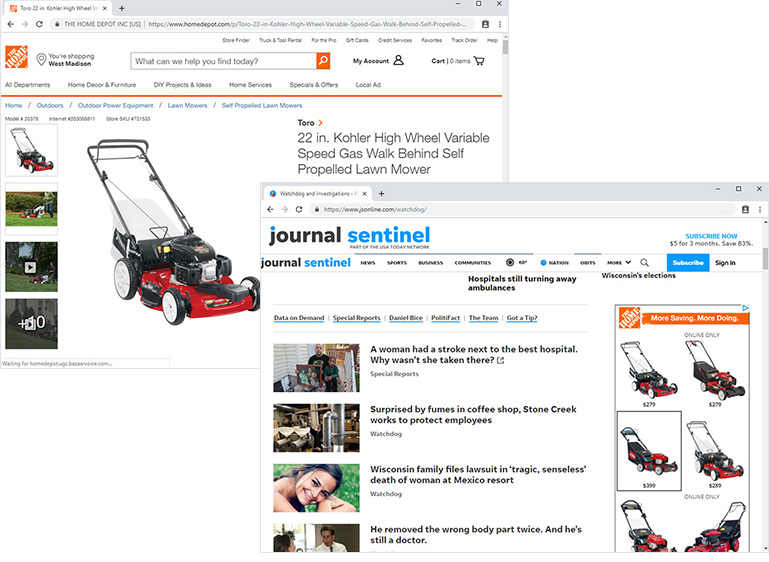Have you ever been to the Home Depot website to look at a lawn mower and then realized that every ad you see on the internet is about Home Depot and their fine selection of lawn mowers? That’s not a coincidence, it’s remarketing.
Remarketing allows companies to follow you around the web with ads based on your behavior, in hopes that you will come back to their site and complete a purchase or request a quote.
 Milwaukee Journal Website with Remarketed Home Depot Advertisement
Milwaukee Journal Website with Remarketed Home Depot Advertisement
Google and Bing both have robust remarketing programs, as does Facebook and LinkedIn. Remarketing is also commonly called “retargeting” depending on the platform but is basically the same thing. Each platform requires you to add a tracking code to your website, called a tag or a pixel, to identify what visitors are looking at. It also writes a cookie in their browser that allows you to serve up the ads as your past site visitors watch Youtube videos, read news articles, view social media sites, etc.
One of the more powerful features of remarketing is that you can tailor your ads based on customer behavior. For example, if you run an e-commerce store that sells children's clothes, you can create a marketing campaign for visitors that view the winter coat category but didn’t reach your checkout page and purchase your product. Advertising campaigns such as this, will then show these specific visitors ads about your winter coats. The beauty in this is that you already know they are looking for a winter coat, so the ad could offer a discount code or free shipping if they come back and complete the purchase.
.jpg)
Clicks and Impressions
Each time your ad is shown to a customer, that is considered an impression. However, with remarketing programs, you typically only pay when someone clicks on your ad and returns to your website. Remarketing campaigns can be quite economical, especially if the campaign is highly targeted to a specific product or product category. The added benefit of a Pay-Per-Click (PPC) remarketing campaign is that those impressions help you build top-of-mind awareness with customers because they are seeing your brand and ads.
What does it cost to run a remarketing campaign?
One of the best features of remarketing and PPC campaigns is the ability to control the budget. When you set up the campaign, you set an overall budget, then you bid on what you’re willing to pay per click within that budget. Now, back to our coat example: let's say you have a budget of $200 per month for your kids coat remarketing campaign. As of April 2019, most of our Google remarketing campaigns are averaging around $.20 per click, so with your $200 budget, you would be able to return (Get clicks from) around 1,000 customers to your site and get thousands of free impressions. In addition to setting a monthly budget limit, you can further control costs by setting frequency capping and geo targeting. You can also stop showing ads when prospects convert to buyers.
.jpg)
Why Should I Consider Remarketing In My Advertising Mix?
Dollar for dollar, remarketing is one of the most cost effective marketing strategies you can implement. Recent studies have shown that around 3% of first time visitors to a site are likely to buy on their first visit. That means 97% of your first time visitors are lost unless you can find a way to get them back to your store. Remarketing allows you to stay connected to your prospects even after they leave your site. A remarketing campaign offers a subtle reminder to your prospects to come back and finish what they’ve started. You will also build more trust in your brand as you continue to gain impressions for your product.